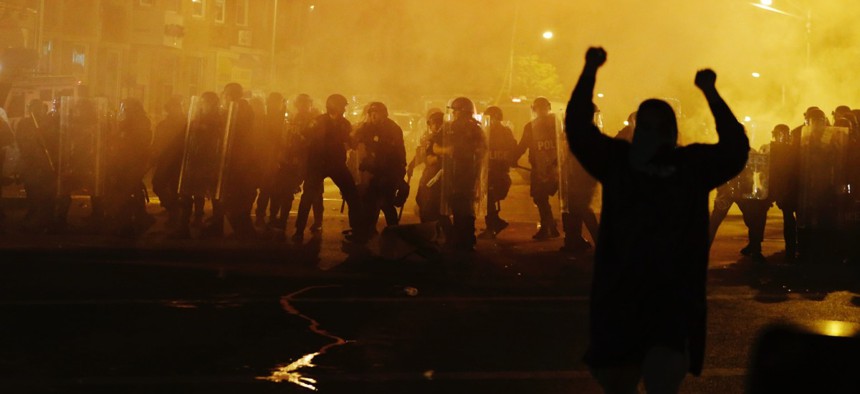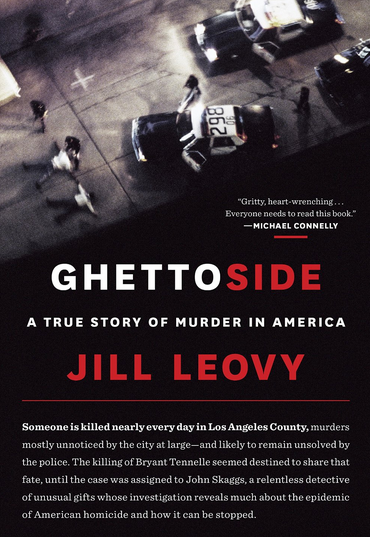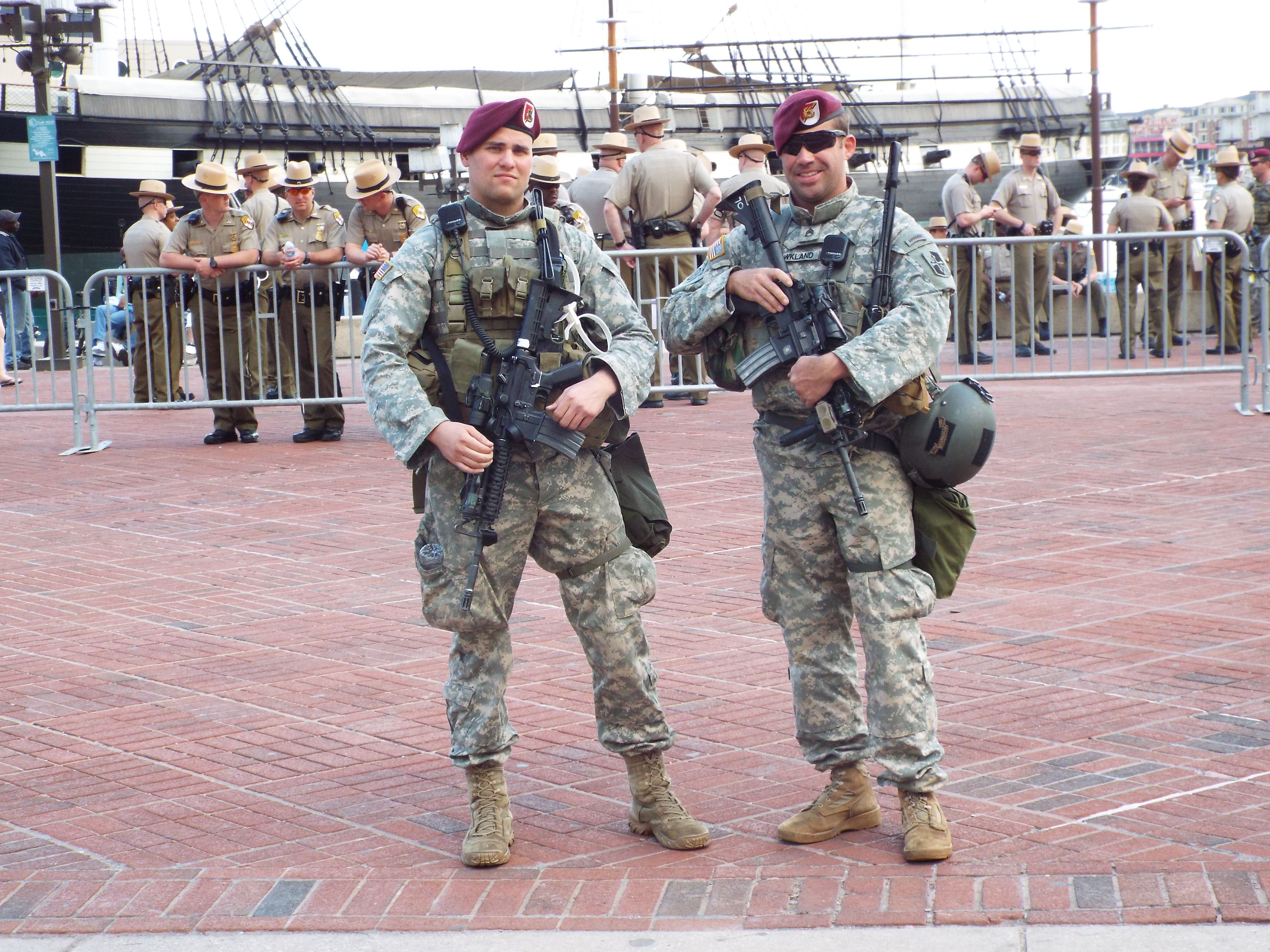New Book Documents Mix of Poverty and Despair That Afflicts Many Homicide-Prone Urban Neighborhoods

Police in riot gear advance on the crowd after a 10 p.m. curfew went into effect in the wake of Monday's riots following the funeral for Freddie Gray, Tuesday, April 28, 2015, in Baltimore. David Goldman / AP Photo
Connecting state and local government leaders
In “Ghettoside,” an investigation of violence in Los Angeles details difficulties in policing in black communities like those that rioted in Baltimore.
BALTIMORE — When Freddie Gray died in the custody of Baltimore police officers on April 19, he could have ended up just a statistic—another black man lost, little noticed, unremembered beyond his community of family and friends.
The riots that ensued ensured another outcome. Fueled by building outrage about police shootings of weaponless black men in Ferguson, Missouri, Staten Island, New York, and elsewhere, Baltimore’s poor, black communities erupted in arson, looting and violence. Demonstrators turned out in force in other cities as well.
Last Friday, Maryland prosecutors announced they had probable cause to level charges of homicide, manslaughter and misconduct against six police officers involved in the Freddie Gray arrest. Whether rough treatment by police was the cause of Freddie’s Gray death, as charged by Marilyn J. Mosby, the state’s attorney for the city of Baltimore, is now a question for the courts. But whatever happened, Gray’s death came in the midst of a continuing epidemic of death-by-murder of black men in American cities.

The causes of these deaths, and their effects on black communities, are the subject of a remarkable new book, “Ghettoside,” by longtime Los Angeles Times reporter Jill Leovy.
Highly praised by critics and experts in urban crime, the book recounts homicides and investigations in South Los Angeles—home to the Watts neighborhood that rioted in 1968—during a decade of reporting from 2001 to 2012. It goes a long way toward explaining how the poverty, despair and fear that afflict majority black neighborhoods from coast to coast devalue black men’s lives and create the conditions for homicides that too often are met with a shrug by white establishments.
These kinds of conditions are found in Baltimore. Prominent local politicians including Martin O’Malley—the former Baltimore mayor and Maryland governor—and U.S. Rep. Elijah E. Cummings, as well as President Obama, have been remarking on the lack of good education, high rates of unemployment and pervasive poverty in neighborhoods like Sandtown, where the riots began after Freddie Gray’s death.
And, indeed, the FBI reported last November that Baltimore had the fifth-highest homicide rate among major U.S. cities—37.4 per 100,000 people—in 2013. Only Detroit, New Orleans, Newark and St. Louis had higher rates. Violent crime, including homicides, have been dropping since the early 2000s, but remain a huge problem in urban African-American communities.
In Baltimore last year, homicides declined to 211, from the 235 recorded in 2013, though the number of juveniles (under age 18) killed rose from 10 to 15. The Sun maintains a continuously updated homicide website that puts killings in 2015 at 70 through April 29—ahead of last year’s pace. Fifty-nine of the 2015 victims, and 189 of those in 2014, were black, according to The Sun’s records.
Media reports from Baltimore have suggested that police misconduct has contributed to the rage that produced the riots. And, indeed, the police department does have a record of brutality and misconduct, producing more than 100 court judgments or settlements against it since 2011, according to a careful investigation by The Sun.
Moreover, during O’Malley’s tenure at Baltimore City Hall, police arrested tens of thousands of people for minor crimes, producing arrest records that have made it even more difficult for many African-American men find jobs in Baltimore. On Wednesday, Baltimore Mayor Stephanie Rawlings-Blake asked the U.S. Department of Justice to investigate whether her city’s police force has engaged in a “pattern or practice” of excessive force.
Killings by police have sparked protests around the country—and a new case emerged in Los Angeles earlier this week, as LAPD Chief Charlie Beck said he was “very concerned” about an officer’s fatal shooting of an unarmed homeless man near the Venice boardwalk.
Yet killings by police remain rare—though recent reporting suggests they may have reached 1,100 in 2014, higher than reported by official sources. And the shootings certainly do not explain the black-on-black killing that infests downtrodden urban neighborhoods.
Not Enough Policing?
Jill Leovy created a similar website, hosted by the Los Angeles Times until 2008, recording thousands of deaths over a period of years. She, among others, was upset that so many of the deaths of young black men tended to go unrecorded by the media, as if they had never existed.
A provocative thesis central to Leovy’s reporting is not that police are too present in crime-prone neighborhoods, but rather that more policing would bring a climate of law-and-order that would deter the epidemic of killings. In the absence of effective law enforcement, gangs stepped in to administer their own codes of justice, often wreaking revenge by knife or by gun.
Mass shootings and celebrity murders earn the attention of the national media, but neither national nor local media focus attention on the people, as Leovy puts it, “who were doing most of the dying: black men.”
“They were the nation’s number one crime victims. They were the people hurt most badly and most often, just 6 percent of the country’s population but nearly 40 percent of those murdered. People talked a lot about crime in America, but they tended to gloss over this aspect—that a plurality of those killed were not women, children, infants, elders, nor victims of workplace or school shootings. Rather, they were legions of America’s black men, many of them unemployed and criminally involved. They were murdered every day, in every city, their bodies stacking up by the thousands, year after year.”
And, writes Leovy, few seemed to care—even the police. As one close observer of the scene in South Central Los Angeles told Leovy, throughout the 1970s police “didn’t care what black people did to each other.”
Still today, people are lamenting such views. On NBC’s “Meet the Press” on Sunday, O’Malley said:
There are people in whole parts of our cities who are being totally left behind and disregarded. They are unheard. They are told they are unneeded by this economy . . . We need to stop ignoring especially people of color and [acting] like they’re disposable citizens in this nation.
And in a poignant speech at Gray’s funeral on April 27, Cummings recounted “how four years ago, ‘I put my nephew in the grave’ after he was fatally shot,” as The Washington Post reported. “‘Still don’t know who did it,’ Cummings told the crowd, his face twisted with grief. ‘I mourn every day . . . Did anyone recognize Freddie when he was alive,’ the congressman demanded, his voice a mix of outrage and despair. ‘Did you see him?’ he thundered. ‘Did you see him? Did you see him?’”
Disposable citizens is what Leovy found in her investigation of homicides in South Central Los Angeles. Her research led her to the conclusion “that the state’s inability to catch and punish even a bare majority of murderers in black enclaves such as Watts was itself a root cause of the violence, and that this was a terrible problem—perhaps the most terrible problem in contemporary American life. The system’s failure to catch killers effectively made black lives cheap.”
The Antidote
Leovy’s tale is built around an “antidote” to the problem, in the form of one particular detective, John Skaggs, and a small number of his colleagues, who made it their business to find, prosecute and convict black-on-black killers.
Murder piled upon murder in the case files of the South Central detectives’ bureau, so many files open, so many witnesses to find in a community that wasn’t often cooperative. Skaggs believed that every case had to be investigated and solved and that the failure to achieve even half that goal meant that homicide victims’ friends would find their own justice in a self-perpetuating cycle of killing.
The book follows one particularly difficult case involving the murder of Bryant Tennelle, the son of an LAPD detective who had, unlike most of his colleagues, chosen to live close by to the most dangerous neighborhoods. At the age of 18, on May 11, 2007, he was gunned down, mistaken for an enemy of a particular gang. In the early 2000s, it was easy to make fatal mistakes like wearing a red garment in a neighborhood whose gangs were enemies of rival gangs whose color was red.
Skaggs, eventually assigned the case, spent months tracking down a witness who would tell him what happened and then weeks preparing to interview the 16-year-old killer, who was already in jail on other charges. More than a year went by before the case came before a judge. Many such cases had failed when witnesses, terrified of retribution, refused to testify in court or perpetrators recanted their confessions. But some of the latter sometimes concluded that their lives would be safer, and longer, if they went to jail.
Bryant’s murderer and an accomplice were convicted and sentenced to life. That enhanced Skaggs’ “clearance rate”—a rate he wanted to be perfect, since every unclosed case is one where justice has not been served.
Clearance rates improved during Skaggs’ tenure in the most violent of the city’s neighborhoods. And crime dropped, as the decade wore on, with homicides and other crimes beginning a nationwide decline that has continued in the last few years. In 2013, the FBI reported 14,196 homicides, down from 15,399 in 2009. (National figures for 2014 have yet to be reported.)
Photo of the National Guard deployed in Baltimore's Inner Harbor following the recent unrest in the city. (Photo by Timothy B. Clark / RouteFifty.com)
Sad March Goes On
But still, the sad march of black mens’ deaths continues. Baltimore homicides have declined from 270 in 2003 to 211 in 2014, though this still ranks the city’s homicide rate as fifth worst among major American cities. And the killing remains concentrated in Baltimore’s African-American neighborhoods, as the 2015 statistics—59 African-Americans among 70 homicides—demonstrate. The Sandtown neighborhood, where the unrest started, suffers a homicide rate that’s twice the citywide average.
The clearance rate on these cases is disturbingly low. As of mid-April, it was just 53.7 percent, according to Baltimore police officials quoted by The Washington Times. And, with definitions of “clearance” varying across the country, the Baltimore clearance rate covers cases referred to prosecutors whether or not they have resulted in convictions.
Clearance rates by this definition have been dropping nationwide, now averaging about 64 percent, according to the Justice Department. That’s in part because of the “don’t snitch” policies adopted by gangs in neighborhoods like West Baltimore and South Los Angeles.
But in what could be a bit of good news for Baltimore, the Justice Department has selected the city as one of six to participate in a new grant program, the Homicide Investigation Enhancement, Training and Technical Assistance Project. The program hopes to identify and spread best practices in solving violent crimes.

NEXT STORY: New Program in New York State Will Distribute Personal Transmitters for Vulnerable Kids




